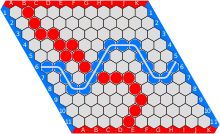
Back Hex (joc) Catalan Hex (brætspil) Danish Hex (Spiel) German Heksludo Esperanto Hex (juego) Spanish Hex Basque بازی هگز Persian Hex French הקס (משחק) HE Հեքս Armenian
 11×11 Hex gameboard showing a winning configuration for Blue | |
| Years active | 1942–present |
|---|---|
| Genres | Board game Abstract strategy game Connection game |
| Players | 2 |
| Setup time | None |
| Playing time | 30 minutes – 2 hours (11×11 board) |
| Chance | None |
| Skills | Strategy, tactics |
Hex (also called Nash) is a two player abstract strategy board game in which players attempt to connect opposite sides of a rhombus-shaped board made of hexagonal cells. Hex was invented by mathematician and poet Piet Hein in 1942 and later rediscovered and popularized by John Nash.
It is traditionally played on an 11×11 rhombus board, although 13×13 and 19×19 boards are also popular. The board is composed of hexagons called cells or hexes. Each player is assigned a pair of opposite sides of the board, which they must try to connect by alternately placing a stone of their color onto any empty hex. Once placed, the stones are never moved or removed. A player wins when they successfully connect their sides together through a chain of adjacent stones. Draws are impossible in Hex due to the topology of the game board.
Despite the simplicity of its rules, the game has deep strategy and sharp tactics. It also has profound mathematical underpinnings related to the Brouwer fixed-point theorem, matroids and graph connectivity. The game was first published under the name Polygon in the Danish newspaper Politiken on December 26, 1942. It was later marketed as a board game in Denmark under the name Con-tac-tix, and Parker Brothers marketed a version of it in 1952 called Hex; they are no longer in production. Hex can also be played with paper and pencil on hexagonally ruled graph paper.